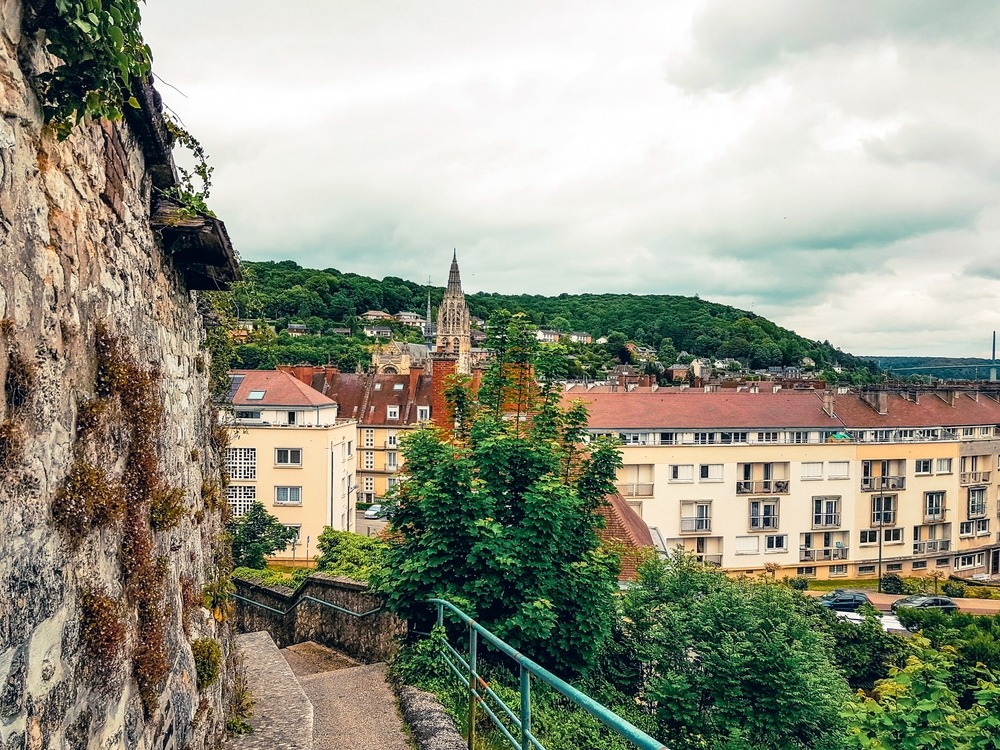Caudebec-en-Caux, France: A Deep Dive into History and Attractions

History of Caudebec-en-Caux
Caudebec-en-Caux, nestled on the right bank of the Seine River in the Normandy region of northern France, is a picturesque town with a history as rich as the verdant countryside surrounding it. Now incorporated into the larger commune of Rives-en-Seine since 2016, the name “Caudebec” is believed to derive from the Old Norse kaldr bekkr, meaning “cold stream”—a reminder of the region’s Viking past and Norse linguistic influence.
Origins and Medieval Development
Human occupation in the area dates back to antiquity, with evidence of Gallo-Roman settlements and activity along the Seine. The strategic location of Caudebec-en-Caux along a major river made it an ideal site for trade and transport from early on. However, the town truly began to flourish in the medieval period, especially from the 10th century onward, as Viking settlers began to colonize and integrate into the Norman duchy. It became an important river port, particularly during the height of Norman power in the 11th and 12th centuries.
In the Middle Ages, Caudebec-en-Caux was a thriving commercial town. By the 14th century, it had established itself as a key maritime hub due to its proximity to Rouen and the English Channel. Goods such as timber, grain, wine, and wool were commonly traded. The town also boasted an active shipbuilding industry.
Renaissance Glory and Religious Turmoil
Caudebec-en-Caux reached the peak of its prosperity during the Renaissance. Its wealth is still visible today in its finely sculpted homes and the breathtaking Flamboyant Gothic Church of Notre-Dame, built between the 15th and early 16th centuries. The town became a center of religious and artistic activity during this period.
However, the Wars of Religion in the 16th century severely impacted the town. Protestant and Catholic tensions culminated in violence, and many structures were damaged or looted. Despite the turmoil, Caudebec retained its economic importance, especially due to river trade and its role in regional governance.
17th to 19th Centuries: Rebuilding and Growth
The following centuries saw a slower pace of growth, but Caudebec-en-Caux remained vital thanks to its river access and agrarian surroundings. By the 18th and 19th centuries, it became known as a resort town of sorts, attracting painters, writers, and travelers drawn to its romantic setting. Tourism began to play a role in the town’s economy, and a number of mansions and bourgeois residences were built during this period.
World Wars and Modern Era
Caudebec-en-Caux endured bombings and conflict during World War II, particularly due to the strategic importance of the nearby Seine River crossings. The destruction included damage to bridges, quays, and parts of the town center. Following the war, the town was carefully restored, preserving many of its most treasured architectural landmarks.
In 2016, Caudebec-en-Caux merged with the neighboring communes of Saint-Wandrille-Rançon and Villequier to form the new administrative entity of Rives-en-Seine. Today, the town stands as a peaceful yet historically vivid riverside community known for its beauty, heritage, and charming atmosphere.

Top 25 Attractions in Caudebec-en-Caux
-
Église Notre-Dame de Caudebec-en-Caux – This Flamboyant Gothic church, built between 1425 and 1540, features remarkable stone tracery, stained glass windows, and ornate sculptures. It is often considered one of the finest churches in Normandy.
-
Maison des Templiers (Templars’ House) – One of the oldest houses in the town, this medieval half-timbered residence now serves as a small local museum showcasing life in medieval Normandy.
-
MuséoSeine – The Seine River Museum – This engaging museum explores the history of navigation and life along the Seine, with exhibits on boat building, river ecology, and the town’s maritime heritage.
-
Pont de Brotonne – This striking cable-stayed bridge crosses the Seine near Caudebec-en-Caux and was one of the first of its kind in France. It offers great views of the river and valley.
-
Quais de la Seine (Riverfront Promenade) – A peaceful walk along the riverbanks with benches, scenic views, and occasional moored barges. Ideal for riverside strolls and photography.
-
Hôtel du Bailli (Bailiff’s House) – A 16th-century building with a richly carved façade, reflecting the town’s Renaissance wealth and elegance.
-
Fontaine du Pilori – An ornate Renaissance fountain located near the town center, traditionally linked to public punishment during the Ancien Régime.
-
Historic Town Center – Winding streets lined with half-timbered houses, Renaissance mansions, artisan shops, and cozy cafés create a storybook Norman setting.
-
Place d’Armes – The central square, often the site of open-air markets and town events, surrounded by historic architecture.
-
Jardin du Cloître (Cloister Garden) – A tranquil garden space situated near the church, ideal for quiet reflection amid stone walls and greenery.
-
Château de Villequier (Nearby) – A short drive away, this historic chateau was once home to Victor Hugo’s family and is connected to the tragic story of his daughter Léopoldine.
-
Victor Hugo Museum in Villequier – Located in the house where Hugo’s daughter drowned, this museum is a touching tribute to the author’s life, love, and grief.
-
Abbaye de Saint-Wandrille (Nearby) – Just outside Caudebec, this functioning Benedictine abbey is a masterpiece of Romanesque and Gothic architecture, with serene grounds and monastic buildings.
-
Valley of the Seine Cycling Trail – The town is a stop along this scenic cycling route that follows the Seine and passes through rolling hills, villages, and riverside vistas.
-
Fête de la Navigation – A lively annual festival celebrating the town’s maritime past with boat parades, music, and cultural displays.
-
Marina of Caudebec – A small riverport where pleasure boats dock, adding nautical charm to the town and offering opportunities for boat rides.
-
Tour d’Harfleur – A medieval tower once part of the town’s fortifications, offering historical insight into the town’s defensive architecture.
-
La Roseraie (The Rose Garden) – A charming public garden filled with rose varieties, tucked beside historic buildings.
-
Maison Gosselin – A historic delicatessen and grocery store that has served locals and visitors for over a century, offering regional products like cider, calvados, and cheeses.
-
Lavoir du Cygne – An old public washhouse that gives a glimpse into 19th-century daily life and community routines along the river.
-
Local Art Galleries – Several small galleries showcase regional painters and sculptors, many of whom are inspired by the Seine and the Norman light.
-
Bois du Parc Nature Trail – A wooded area just beyond town perfect for short hikes, birdwatching, and enjoying native flora.
-
Fishing on the Seine – Popular with locals, the river offers fishing for pike, perch, and carp. Permits are available for visitors.
-
Weekly Market (Marché Hebdomadaire) – Held in the town square, the market features fresh produce, Normandy cheeses, baked goods, and regional specialties.
-
Viewpoint at the Chapelle Saint-Clément – Located on a nearby hill, this small chapel and its surroundings provide panoramic views of the Seine Valley and town.

Caudebec-en-Caux may be small in size, but it is vast in heritage and charm. With its elegant Gothic church, quaint riverfront, historic homes, and deep roots in Normandy’s Viking, Renaissance, and wartime past, the town offers visitors a uniquely intimate experience of French history. Whether you’re tracing the steps of medieval traders, reflecting on the literary legacy of Victor Hugo, or simply savoring cider by the Seine, Caudebec-en-Caux invites a slower pace and a deeper appreciation for culture and time.

































